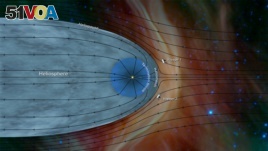16 May 2021
Scientists say NASA's most distant exploring spacecraft has recorded what they describe as ‘humming' beyond our solar system.
A new study suggests the continuous hum, detected by the Voyager 1 spacecraft, is caused by waves existing in interstellar space. Voyager 1 left our solar system eight years ago, crossing the border that divides our solar system from interstellar space.
"Interstellar" means "between stars." Scientists say interstellar space begins where the sun's continual flow of material and its magnetic field stop.
Researchers say instruments on Voyager 1 identified the waves as vibrations in small amounts of gas found in the near-emptiness of interstellar space. The vibrations are also known as plasma waves. The spacecraft detected the waves over several years at different radio frequencies.
Results from Voyager 1's findings were recently published in a study appearing in Nature Astronomy.

Data from the NASA spacecraft Voyager 2 has helped further characterize the structure of the heliosphere — the wind sock-shaped region created by the sun's wind as it extends to the boundary of the solar system, as depicted in this image released by NASA.
Astronomers believe the space that Voyager 1 is passing through -- known as the interstellar medium -- is filled with different kinds of waves, both big and small. Such waves can provide information about the density of the interstellar medium.
The new research was led by Stella Ocker, a doctoral student at New York's Cornell University and a member of NASA's Voyager 1 team. She was able to make the discovery by examining data slowly sent back by Voyager 1 from about 23 billion kilometers away.
Ocker told Reuters the newly identified plasma waves would be far too weak to be heard with the human ear. "If we could hear (the hum), it would sound like a single steady note, playing constantly but changing very slightly over time."
When the plasma waves are changed to an audio signal, the tone of the sound changes, added James Cordes. He is an astronomy professor at Cornell University and the co-writer of the study. That sound is "a bit eerie," he said.
NASA said in a statement the new discovery may be the first continuous measurement of the density of material in interstellar space. Ocker added: "This detection offers us a new way to measure the density of interstellar space and opens up a new pathway for us to explore the structure of the very nearby interstellar medium."
In the past, Voyager 1 had detected more powerful wave movements in interstellar gas linked to flares from the sun. But the new study suggests that continuous vibrations unrelated to solar activity could be normal in interstellar space.
The researchers said the findings provide evidence that there is more low-level activity in interstellar gas than scientists had thought.
Ocker said her work can lead to a better understanding of how the interstellar medium interacts with solar wind, the continuous flow of charged particles released by the sun. It can also provide data about how the heliosphere -- a protective bubble for our solar system – is shaped and changed by interstellar conditions.
Voyager 1 was launched in 1977 along with another NASA spacecraft, Voyager 2. Both spacecraft were designed to explore Jupiter and Saturn. Voyager 1 entered interstellar space in 2012 and is still actively collecting and sending data.
In 2019, NASA reported that Voyager 2 had also discovered new details about interstellar space.
The two Voyagers were expected to last only five years. Both long outlasted their operational lifetimes, but are expected to run out of power and go silent within five years.
However, Cordes said new spacecraft are already being designed and developed with the goal of traveling even farther beyond our solar system. "That is the message I find appealing: our reach is expanding into interstellar space," he said.
I'm Bryan Lynn.
Bryan Lynn wrote this story for VOA Learning English, based on reports from the Cornell Chronicle, NASA, Reuters and Nature Astronomy. Mario Ritter, Jr. was the editor.
We want to hear from you. Write to us in the Comments section, and visit 51VOA.COM.
_______________________________________________________________
Words in This Story
detect – v. to discover or notice something
vibration – n. a continuous, quick, shaking movement
frequency – n. the number of times a wave, especially of light, sound or radio wave, is produced within a particular period
steady – adj. happening in a smooth, continuous way
constant – adj. happening a lot or all the time
tone – n. a sound with a definite pitch and vibration
eerie – adj. strange in a mysterious way
flare – n. a sudden increase in brightness
bubble – n. an enclosed or isolate space